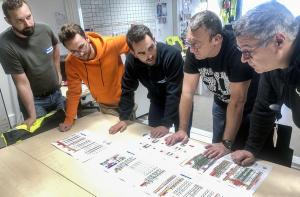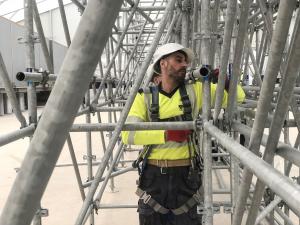The scaffolding that makes every task possible
Imagine you have a massive LEGO kit with 1,600 different types of references and you need to build hundreds of one-of-a-kind structures while facing challenging deadlines. Oh, and the kit weighs more than 1,500 tonnes and if a structure isn't perfectly precise, it could result in severe injuries, millions in damage, and weeks of lost time. That, in a nutshell, is the job of the scaffolding team at ITER.
"Sometimes it's so complex I get goosebumps," says Roberto Mignone, construction configuration officer and scaffolding contract manager in the Construction Management Office. "Most people don't notice the scaffolding because it is such a common sight, but it's an important backbone of any construction worksite and even more so at ITER."
As construction and assembly accelerate at ITER, the demand for scaffolding is increasing. There are currently about 800 scaffolds in use on the site and every month there are more than 300 new scaffolding jobs that need to be done, without considering the modification and dismantling tasks.
When most people think of scaffolding, they envision basic facade scaffolding erected to paint a building or work on the roof of a house. At ITER, the scaffolding is used for a broad range of purposes, from providing workers with access to difficult-to-reach areas to shoring up multi-tonne components until their assembly is completed. This means that a scaffolding job can be anything from a 2x2x2 metre platform needed to install a cable tray support, to an immense 50-metre tower for workers installing HVAC systems right below the roof of the Tokamak Building.
All of this is the responsibility of ITER's Construction Management Office (CMO), ITER's Construction Management-as-Agent contractor MOMENTUM, and the scaffolding contractor Entrepose Echafaudages. And at the heart of the process is Roberto, who has been working in construction management since 2016.
"A large part of the job is coordinating the installation," says Roberto. "It is a bit of a puzzle to get the scaffolding erected on deadline without interfering with other assembly activities. That's why so much of our work for the most complex areas is done at night."
To manage all the projects, Roberto collaborates with MOMENTUM's four-person scaffolding team and more than 50 other workers from Entrepose Echafaudages. MOMENTUM's Gilbert Mamadou, with more than 30 years of experience, is responsible for the activities in the core of the ITER Tokamak pit. He says the project is perhaps his most demanding mission in terms of complexity and coactivity.
"I am not building cathedrals, but each structure is a challenge," says Gilbert. "We have a more sophisticated level of scaffolding compared with other worksites. At ITER, there are highly technical zones and components where you need to work with great care for the surrounding items as any impact might have dramatic repercussions on unique components."
One of these big challenges came in December 2021 when the Sector Modules Delivery & Assembly Division reached out to Roberto with a critical job: there was no permanent access structure on the first vacuum vessel sector sub-assembly tool (SSAT#1) in the Assembly Building and the contractor needed to reach the upper parts in April 2022. Scaffolding was needed!
When the order for the SSAT#1 arrived, Roberto activated his on-site team, plus a team of Entrepose Echafaudages designers in Paris. They immediately began working on a 3D model and, after two months of coordination, the blueprints were validated. Then the team started to prepare and deliver the components, which had to meet the cleanliness requirements of the assembly area (parts needed to be brand new or carefully cleaned prior to entering the building). The specially designed scaffold was erected during five night shifts in March 2022 and, after an inspection by Bureau Veritas, it was declared fit for use by the personnel.
"The SSAT#1 job was a specific design that shows how flexible you can be with scaffolding compared to a welded structure," says Roberto.
Scaffolding projects in the tokamak pit face another layer of complexity: material. With typical scaffolding made of zinc-coated carbon steel, there is a risk of contamination to the surfaces of the tokamak and rusting; at the same time, aluminium is not robust enough for the load requirements in that area. ITER and the scaffolding provider solved the dilemma by developing a bespoke material, and now almost 100 tonnes of innovative carbon-free scaffolding are available for the cleanest and more complex area of the project.
For Christophe Jeanmougin, manager for Entrepose Echafaudages on the ITER site, projects like "the beam" and the SSAT#1 scaffolding are what make his job so passionate. "It's hard. We've worked Christmas, holidays, nights ... we sacrifice a lot. But we have committed people and we know how important ITER is, so we are ready to do what it takes as part of the team to reach the necessary milestones."





